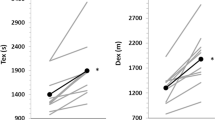Abstract
A cooling system (Mark VII Microclimate System) was used to give six thermosensitive multiple sclerosis patients two 45-minute daily coolings for a period of one month. Before the first cooling, a baseline clinical and electrophysiological examination was performed. The same tests were repeated after the first application and after the thirtieth cooling day, thus providing information relating to acute and chronic efficacy. A clinical improvement was observed after both acute and, more unexpectedly, chronic cooling, whereas a significant improvement in central somatosensory conduction was recorded only under acute conditions. Our data suggest that cooling with this device leads to an improvement in some functional performances (mainly fatigue and strength) of about two hours' duration in thermosensitive patients.
Sommario
Abbiamo applicato un semplice sistema di raffreddamento (Mark VII Microclimate System) a sei casi di sclerosi multipla (SM) termosensibili, con due sedute giornaliere di 45 minuti ciascuna, per la durata di un mese. La prima seduta è stata preceduta da una valutazione clinica ed elettrofisiologica completa ripetuta dopo il primo raffreddamento e dopo il trentesimo giorno di applicazione, ottenendo quindi informazioni di efficacia in “acuto” e in “cronico”.
Un miglioramento clinico soggettivo e obiettivo è stato rilevato sia dopo la prima applicazione che dopo il raffreddamento cronico, mentre, fra i parametri elettrofisiologici, soltanto le latenze dei potenziali evocati somestesici da stimolazione del nervo tibiale posteriore sono diminuite in maniera statisticamente significativa in “acuto”.
I nostri dati suggeriscono che il sistema di raffreddamento applicato ai casi di SM termosensibili quò determinare il miglioramento di alcuni sintomi, soprattutto spasticità, per una durata media di due ore.
Similar content being viewed by others
References
Abruzzese G., Schenone A., Scramuzza G. et al.:Impairment of central motor conduction in diabetic patients. Electroenceph. Clin. Neurophysiol. 89: 335–340, 1993.
Abruzzese M., Favale E., Leandri M., Ratto S.:New subcortical components of the central somatosensory evoked potential in man. Acta. Neurol. Scand. 58: 325–332, 1978.
Anonymous.Temperature change and multiple sclerosis. Br. Med. J., 2: 506, 1972.
Bassett S.W., Lake B.M.:Use of cold application in management of spasticity: report of three cases. Phys. Therapy Rev. 38: 333, 1958.
Boynton B.L., Garramone P.M., Buca J.:Cool baths as adjunct in treatment of patients with multiple sclerosis. Quart. Bull. Northwest Univ. Med. School, 33: 6, 1959.
Chiappa K.H.:Short-latency somatosensory evoked potentials: methodology. In Chiappa K.H. (Ed.)Evoked Potentials in Clinical Medicine. New York: Raven Press, 320–323, 1989.
Davis F.A., Jacobson S.:Altered thermal sensitivity in injured and demyelinated nerve: a possible model of temperature effects in multiple sclerosis. J. Neurol. Neurosurg. Psychiatry 34: 551–561, 1971.
Fruhstofer H., Lindblom U., Schmidt W.G.:Method for quantitative estimation of thermal thresholds in patients. J. Neurol. Neurosurg. Psychiatry 39: 1071–1075, 1976.
Hopper, C.L., Mattheus C.G., Cleeland C.:Symptom instability and thermoregulation in multiple sclerosis. Neurology 22: 142–148, 1972.
Kurtzke J.F.:Rating neurologic impairment in multiple sclerosis: an expanded disability status scale (EDSS). Neurology 33: 1444–52, 1983.
Nelson D.A., Jeffrey W.H., McDowell F. Effects of induced hyperthermia on some neurological diseases. Arch. Neurol. Psychiatry, 79: 31–39, 1958.
Poser C.M., Paty D.W., Scheinberg L. et al.:New diagnostic criteria for multiple sclerosis: guidelines for research protocols. Ann. Neurol. 13: 227–231, 1983.
Rasminsky M.:The effects of temperature on conduction in demyelinated single nerve fibres. Arch. Neurol. 28: 287–292, 1973.
Simons D.J.:Note on effect of heat and of cold upon certain symptoms of multiple sclerosis. Bull. Neurol. Inst. New York, 6:385, 1937.
Symington G.R., Mackay I.R., Currie T.T.:Improvement in multiple sclerosis during prolonged induced hypothermia. Neurology, 27: 302–303, 1977.
Tartaglione A., Oneto A., Bandini F. et al.:Electrophysiological detection of “silent” plaques in the optic pathways. Acta Neurol. Scand. 76: 246–250, 1987.
Tourtellotte W., Syndulko K., Woldanski A. et al.:Objective evaluation of daily cooling for symptomatic treatment in MS. Poster in Multiple Sclerosis: Approaches to management. Session “Managing individuals with multiple sclerosis”. Victoria, Canada. September 10–13, 1993.
Watson C.W.:Effect of lowering of body temperature on the symptoms and signs of multiple sclerosis. N. Engl. J. Med. 261: 1253–1259, 1959.
Author information
Authors and Affiliations
Rights and permissions
About this article
Cite this article
Capello, E., Gardella, M., Leandri, M. et al. Lowering body temperature with a cooling suit as symptomatic treatment for thermosensitive multiple sclerosis patients. Ital J Neuro Sci 16, 533–539 (1995). https://doi.org/10.1007/BF02282911
Received:
Accepted:
Issue Date:
DOI: https://doi.org/10.1007/BF02282911




